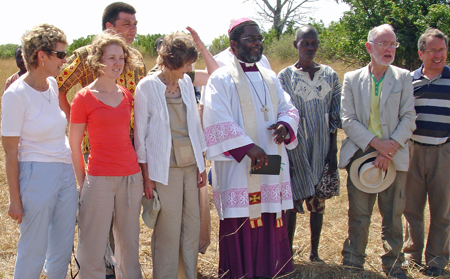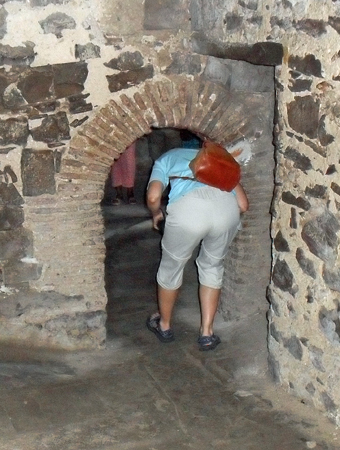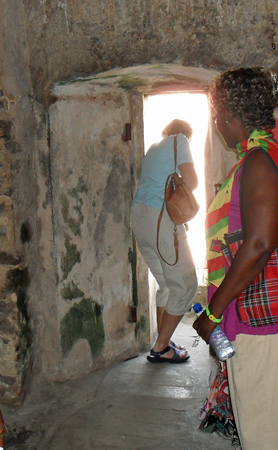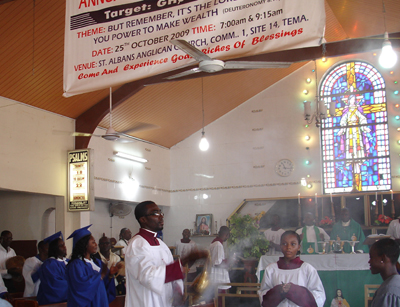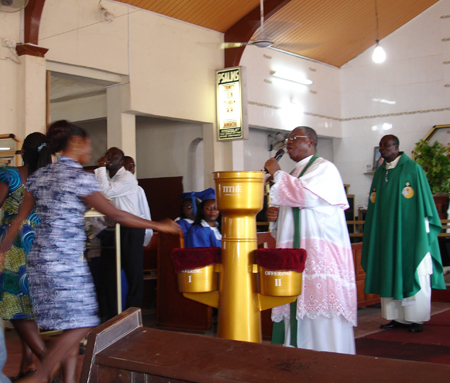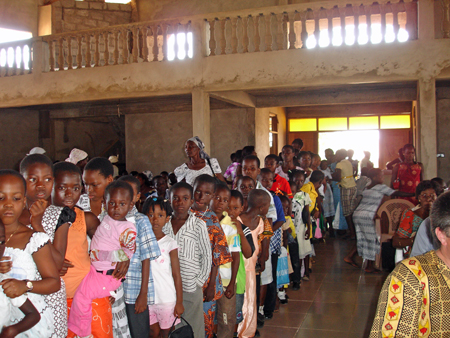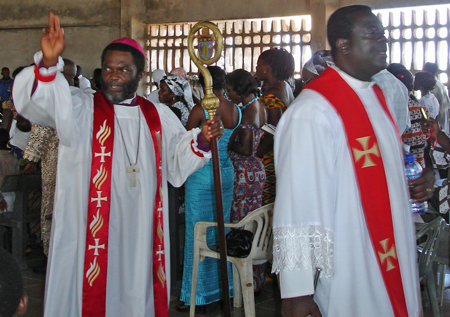Reflections
on a
Ghanaian Experience
Liz
Mooney
Liz is parish
administrator for the
United Benefice of St Faith's Great Crosby and St Mary the Virgin,
Waterloo Park. She works from the parish office at St Mary’s
and
worships at another St Mary’s, at Edge Hill in Liverpool. She tells us
of her recent epic journey to Ghana.
The
team at Buako Ground-Breaking Ceremony
with Archbishop Akrofi and the tribal Chief
On Friday 9th October, 2009, an
eclectic bunch of Christians left Liverpool and journeyed to Ghana to
join a medical mission. Whilst none of us had any medical
backgrounds, we were going to serve in whatever capacity we could and
we joined a twenty-strong American team who although similar to
ourselves had the added bonus of a couple of nurses and a
dentist! We were all part of “Branches of the Vine” (John 15:5) a
non-profit organisation that partners with the Anglican Diocese of
Accra in providing medical and educational assistance in West Africa,
predominantly in the country of Ghana. Although formally
established in 2006, their work began in 1995 when a small group of
Americans partnered with Dr Justice Akrofi, Archbishop of the Anglican
Church of the Province of West Africa and Bishop of Accra, and the need
to assist him in spreading his vision throughout West Africa.
“Branches of the Vine” are committed to supporting the Ghanaians in
their mission to evangelize their people, with time, talents and
resources. They have a heart for mission and a commitment to
serve God.
My own association with Ghana began in 1996 when Maria, a Ghanaian lady
joined our congregation at St Mary’s Church, Edge
Hill. Studying in Liverpool to become a consultant
anaesthetist, this lady was Dr Maria Akrofi wife of Dr Justice
Akrofi. With Maria and her family playing a significant part in
my own spiritual formation and having been unable to go to Ghana last
year, 2009 was right and in God’s timing. So here are a few
reflections on my experience!
As soon as you arrive in Ghana, you know that God is at work! The
people are very warm and friendly, and they like to demonstrate their
faith by naming their businesses after religious sayings. Here
are some that I noted:
The Lord is my Light Fashion
King of Kings Fast Food
Jesus is Lord MTN Phone Cards
God’s Time Auto Electrical
Blessed Beauty Salon
Christ Way Ventures
In God’s Will We Trust Hair Salon
Innocent Blood Restaurant
In God We Trust Fitting Shop
Justice Haircut
Ghana, like many African countries, participated in the trans-Atlantic
slave trade. Therefore, a visit to a slave castle is part of any
African experience. Elimina Castle was built by the Portuguese in
1482 and originally it was used as a trading post where the Portuguese
exchanged guns, gunpowder, liquor, enamel bowls, tobacco and iron bars
for gold, ivory, spices and artefacts. Early in the 16th century
the trans-Atlantic slave trade started and the slaves were kept at the
castle before transportation all over the world. Men and women
were separated, kept in squalid conditions which only got progressively
worse.
When the ships arrived, the men and women briefly saw each other for
the first time since incarceration at the castle and had to duck as
went through a very short door and entered the “room of no
return”. The captives did not move freely as they were in chains
and chained to each other. In these chains, they made their final
exit from the castle through a door (now known as the “door of no
return”), and descended a ladder to canoes and finally entered the
ships to begin another dreadful journey to unknown places in the world.
This door was extremely narrow, but after months of starvation diets
and ill treatment, they were just skin and bone and so all fitted
through very easily.
The short door
The door of no return
The ships were the worst leg of the captives’ journey, with the
Africans being made to lie side-by-side on the decks unable to move or
sit up. With their hands and legs in chains, the captives defecated and
vomited all over themselves. On one ship it was recorded that of
700 captives taken, only 350 survived the voyage.
Having briefly looked at the past, now was the time to look to the
future. On our first Sunday the team split up and went to worship
at a number of different churches. I went to St Alban’s, Tema.
Transport around Ghana is not easy and what starts out as a tarmac road
rapidly disintegrates into a dirt track with endless potholes.
Suffice it to say that after a very early start, we arrived at St
Alban’s about 10am to find everyone sitting in bible study
groups. Our party joined the English-speaking group, who
were studying Anglicanism and the Creeds. As we later moved into the
service it came as a surprise to be handed a 1950s copy of the Book of
Common Prayer. In Ghana, whilst the official language is English.
there are over 50 different African languages spoken and over 70
different dialects. Consequently, services are conducted both in
English and the local language. Resources are very limited, hence
everyone knows the Book of Common Prayer and as there is a very strong
oral tradition, new hymns are taught and memorised! Apart from the
sheer joy and exuberance of the service, two particular highlights were
the offering and the imaginative use of the incense. The offering
happens not once, but twice, sometimes three or more times during a
service! The priest and choir sing, accompanied by any musicians
and everyone else dances up to the front, waving white handkerchiefs
and then places money in the offering receptacles.
Rocking
with the
incense
Collection time
The Medical Mission took place on Monday, Tuesday, Friday and Saturday
and over the four days 1,230 patients were seen at Akwaaba, Buako and
New Ningo. For nationally known puppeteers Ian and Elaine Couls
from Liverpool, this was their second visit to Ghana, and the previous
week they had provided training in making hand puppets and performing a
puppet show. They were a hit with both the children and adults,
sharing the gospel with all who waited patiently for hours at a time to
be seen by the medical team, who were mostly Ghanaian. I was most
gainfully employed working with one of the American nurses, recording
temperatures and blood pressure readings! I have to say that prior to
the mission, there were “prayer warriors” in Ghana who fasted and
prayed for weeks before the mission started. Indeed, before we
did anything we prayed and certainly before any travel! We prayed
before we departed and upon a safe arrival, immediately gave
thanks!
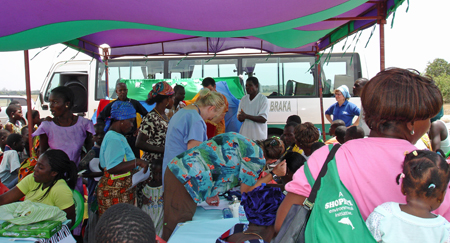
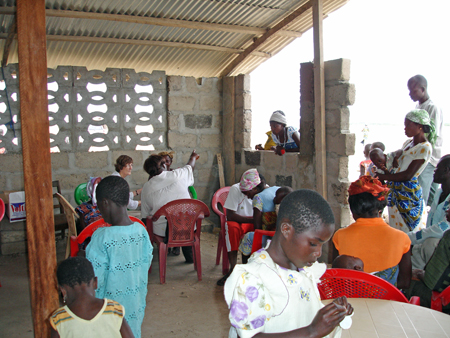 Waiting at Akwaaba
Prayer at Akwaaba
Waiting at Akwaaba
Prayer at Akwaaba
Other highlights of the mission were visiting a prison at Akusha. A
prison for minor offences, many had no bed and slept on the floor. We
distributed blankets, bibles and food. A visit to a community
called Twerbo was most enlightening. Ten years ago the villagers
contracted many water-borne diseases from a polluted water
source. Now through the intervention of Branches of the Vine,
they have a well, a school, a church and are in much better
health. A similar project is required for the communities of
Akwaaba and Buako and the Liverpool contingent have pledged to raise
the £26,000 to fund this. With £12,000 being already
raised there is another £14,000 to go. During our visit, there
was a ground-breaking ceremony with the Archbishop at Buako.

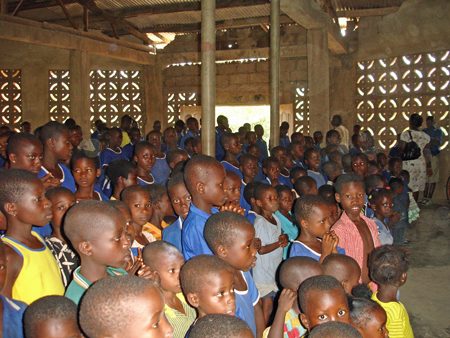 At Twerbo: a
classroom
Inside the church
At Twerbo: a
classroom
Inside the church
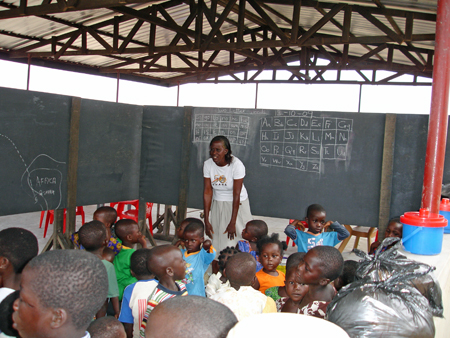
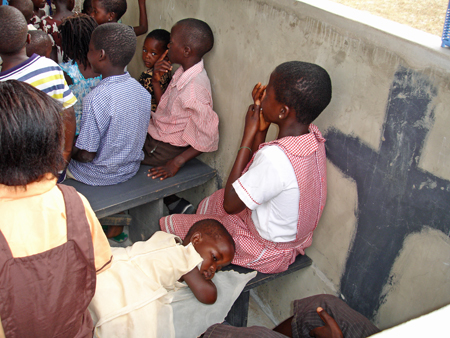
All-age
classroom
It's hard to stay
awake!
For me, the highlight of the whole week was the “Healing Service” on
our final Sunday. Starting at 9.30am, it lasted for 5 hours without a
break! It started with a normal service and then at about 12 noon
just moved into a healing service. The Archbishop was there as he was
at some point during most of the events. However, the greatest
privilege of all was praying for individuals. Each person was
given a piece of paper and on it they wrote their name and what they
wanted praying for. A job, a better job, their family, health,
forgiveness from a number of temptations not pleasing to God,
business success and a long life were just some of the
things I was asked to pray for. Their humility and
openness was something to behold, together with their
strong belief that Jesus really could transform their lives. And
it was not just the adults who came forward; all the children did as
well!
Queue for prayer at
the
healing service
Archbishop Akrofi and Fr Bernard
I have so much more to tell but unfortunately have no space! Our
mission was very much “Go, See and Tell!” If you would like to
know more about the work of “Branches of the Vine” or feel you would
like to make a donation to support their work then have a look at their
web site www.thebranchesofthevine.org
Photos: Liz Mooney
